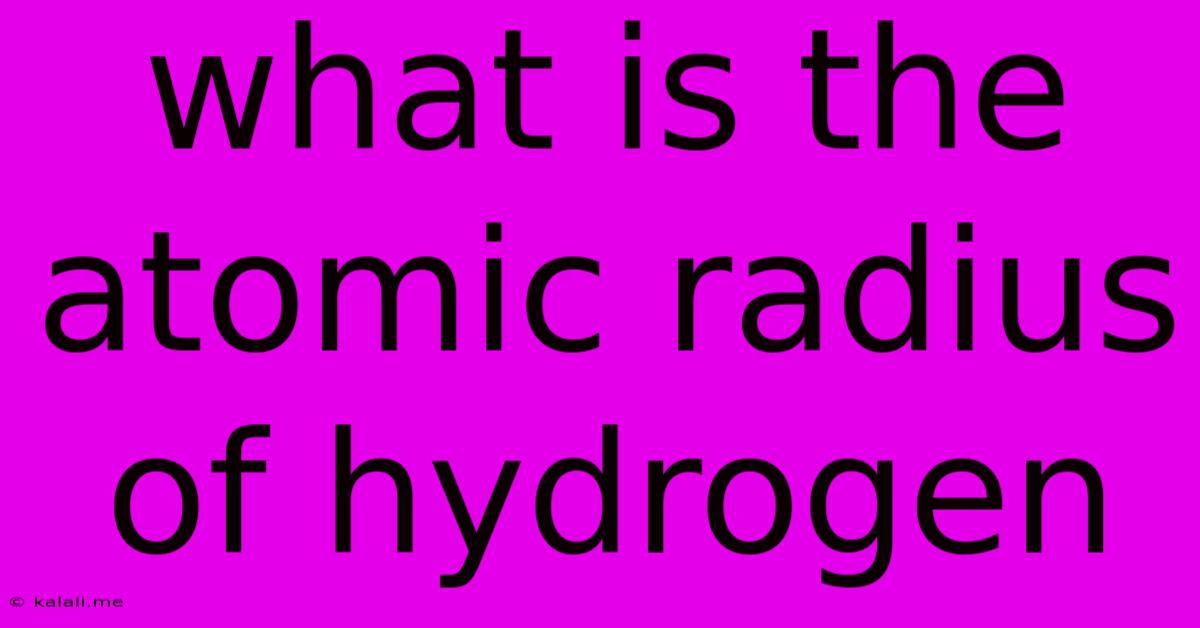What Is The Atomic Radius Of Hydrogen
Kalali
Jun 14, 2025 · 3 min read

Table of Contents
What is the Atomic Radius of Hydrogen? Understanding the Size of the Smallest Atom
The atomic radius of hydrogen, the simplest element in the periodic table, is a surprisingly complex topic. While a single, definitive number isn't easily stated, understanding the factors influencing its size and the different ways to measure it provides a comprehensive picture. This article delves into the intricacies of hydrogen's atomic dimensions, exploring covalent, metallic, and van der Waals radii.
What exactly is atomic radius? It refers to the distance from the atom's nucleus to its outermost stable electron shell. However, the fuzziness of electron clouds means there's no hard and fast boundary. Different methods of measurement yield varying results, depending on the type of chemical bond involved. This is especially true for hydrogen, which readily forms various types of bonds.
Measuring Hydrogen's Atomic Radius: The Challenges
Unlike larger atoms with multiple electron shells, hydrogen's single electron makes it uniquely challenging to define its atomic radius precisely. Its small size and the behavior of its single electron significantly impact measurement. The radius can vary significantly based on the bonding environment of the hydrogen atom.
Different Types of Hydrogen Atomic Radius
Several methods exist to measure atomic radius, each producing a different value:
-
Covalent Radius: This is half the distance between the nuclei of two hydrogen atoms bonded together covalently. In a dihydrogen molecule (H₂), this measurement is approximately 37 pm (picometers) or 0.37 Ångströms. This is commonly cited as the atomic radius of hydrogen.
-
Metallic Radius: This method is relevant for metals, and while hydrogen can behave metallically under extreme pressure, it's not its typical state. Therefore, a metallic radius isn't typically reported for hydrogen under standard conditions.
-
Van der Waals Radius: This represents the distance between the nuclei of two hydrogen atoms when they are not bonded chemically, but are held together by weak van der Waals forces. This radius is generally larger than the covalent radius. For hydrogen, this radius is approximately 120 pm. This value is useful when considering interactions between non-bonded hydrogen atoms, such as in molecular packing.
Factors Affecting Hydrogen's Atomic Radius
Several factors influence the apparent size of a hydrogen atom:
-
Electron-Electron Repulsion: While hydrogen only has one electron, the repulsion between electrons in different hydrogen atoms influences the bond length and therefore the measured radius, particularly in covalent interactions.
-
Nuclear Charge: The positive charge of the proton in the hydrogen nucleus attracts the single electron, influencing the electron cloud's size.
-
Bonding Type: The nature of the chemical bond (covalent, metallic, or ionic) significantly affects the distance between the nuclei, impacting the measured radius.
Conclusion: Context is Key
There's no single answer to "what is the atomic radius of hydrogen?" The value depends heavily on the method of measurement and the context. While the covalent radius of approximately 37 pm is frequently cited, it's crucial to remember that the radius can differ based on the conditions and the type of interaction involved. Understanding these nuances provides a more complete understanding of this fundamental element's properties. Remember to always specify the type of radius when discussing hydrogen's atomic dimensions to avoid confusion.
Latest Posts
Latest Posts
-
Charge Of An Alpha Particle In Coulombs
Jun 14, 2025
-
Causes And Effects Of The Renaissance
Jun 14, 2025
-
Which Of The Following Statements About Dna Structure Is True
Jun 14, 2025
-
Different Between Short Run And Long Run
Jun 14, 2025
-
Which Location Is The Flattest Part Of The Ocean
Jun 14, 2025
Related Post
Thank you for visiting our website which covers about What Is The Atomic Radius Of Hydrogen . We hope the information provided has been useful to you. Feel free to contact us if you have any questions or need further assistance. See you next time and don't miss to bookmark.